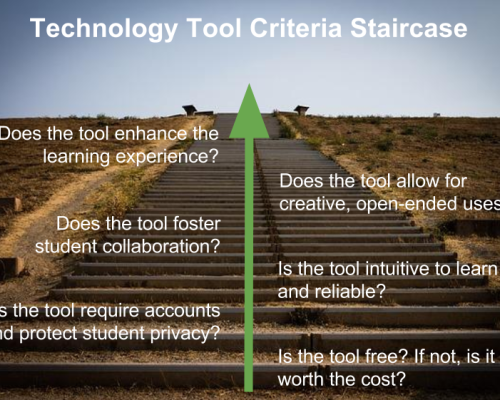Choosing the Right Classroom Tools
Date
Type “best tech tools for education” into a Google query and you’ll be bombarded with Top 10 lists broadcasting the latest must-have tools for the classroom. Browse through education sections of app stores and you’ll encounter an eye-opening number of apps promising to enhance teaching and learning. Without a doubt, many of these tools are potentially game-changing, redefining the way teachers and students operate.
The problem for teachers is definitely not a shortage of technology tools to choose from but instead, being able to sort through the noise to find the right tools for their classrooms and their students. What really makes an effective tool for the classroom?
Criteria for Evaluating Tech Tools
One of the most helpful blog posts I’ve read on the topic is Nik Peachey’s post on criteria of effective technology tools. Even though he targets mobile apps for English language teachers, he outlines four distinct categories that are helpful for thinking about technology tools across the subject areas:
- Technical: Does the tool meet device specifications, and is it reliable and easy for students and teachers to use?
- Financial: How much does the tool cost? If it’s free, does it display ads or operate on the “freemium” model?
- Motivational: Does the tool engage students and allow for personalization of learning?
- Pedagogical: Does the app achieve your desired purpose and represent instructional best practices?
But simply defining the criteria isn’t enough. Educators still need to prioritize criteria and develop a system for effectively evaluating tools. A number of app evaluation rubrics and checklists attempt to do just that. But in my experience, while they were effective starting points, none of these were exactly right for me.
When I was a teacher transitioning to a one to one classroom, I spent the better part of a summer exploring and identifying tools that I wanted to use with my students. Gradually, once I determined the qualities of the tools I was looking for, I developed my own process. I chose Explain Everything because it didn’t require account creation, it stored work directly on student devices, and it empowered students to share their thinking in flexible ways across content areas. I decided Edmodo was worth sending permission slips home for because it helped create an online community for my fourth graders. Once I understood what I was looking for, picking the right tools for my situation from the vast landscape of education tools became more manageable.
A Personal Process
Recently, I worked with a few other educators to share ideas and see if we could develop a more universal resource for others to use. In the end, the lesson I learned is that, much like teaching itself, choosing the right technology tools is an extremely personal process. Each teacher is unique. They work in districts and schools with their own requirements, teach different age levels and subject matter, and work with students with very individualized needs. There is no cookie cutter solution for choosing tools. Just as no two teachers will teach in exactly the same style, no two teachers will have the same criteria or process for how they choose the tools for their classroom.
According to this New York Times article, venture and equity financing for edtech companies is at record levels, up 55% from last year. In an increasingly crowded technology tool landscape, value lies in giving individual teachers the time and support they need to go through the process of defining how they choose the right tools for their practice. Then, in the end, these teachers may be able to effectively guide their students through a similar process of independently making the correct choices about educational tools that benefit their learning.

